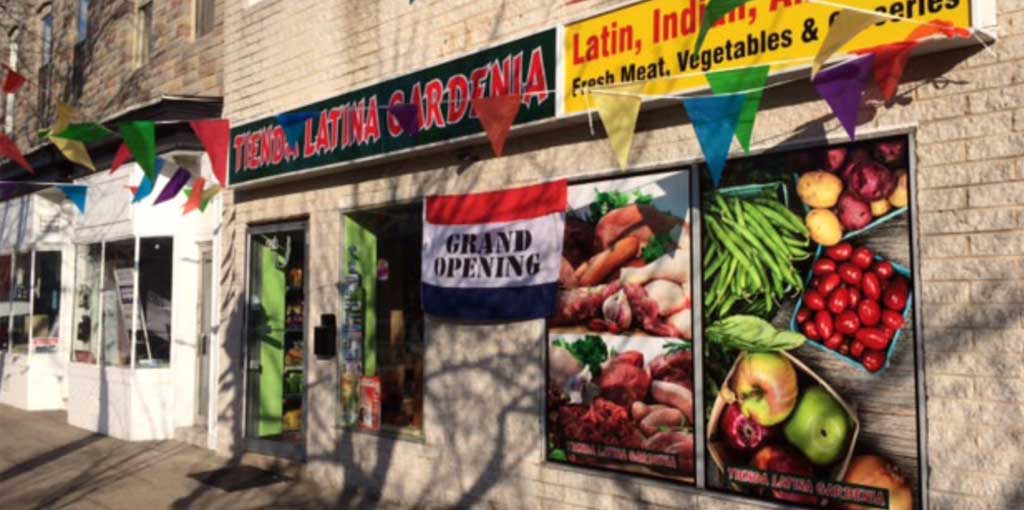“There were grocery stores all over the neighborhood.”
Every time a Highlandtown old-timer has a conversation, this sentence is uttered at least once.
The standard reaction is “Huh,” or “Oh yeah?” but think about it.
The humble corner grocer factors heavily into Baltimore lore. A Czech grocer named William Oktavec painted the screens of his store at the corner of Collington and Ashland avenues with depictions of the fresh produce he sold inside. The art form became a major part of Baltimore folklife, and after fading from the scene for a few decades, is today in the midst of a major resurgence.
As is the privately-owned, neighborhood grocery store.
In Highlandtown, anyway, ttienda-gardeniahey seem to be on every block–Tienda Latina Gardenia, 429 S. Conkling St.; Cinco de Mayo, 417 S. Highland Ave.; the Markets at Highlandtown, 3801 Eastern Ave.; DiPasquale’s Italian Marketplace, 3700 Gough St., and so on.
The lengthy list elicits an astute observation from Amanda Smit-Peters, manager of Highlandtown Main Street, a program of the Southeast Community Development Corp.
“We’re not a food desert,” she says.
It’s true; a 2012 Baltimore City food environment map from the Department of Planning shows a Highlandtown largely free from red, the color that indicates a food desert (distance to a supermarket over a quarter mile, median income at or below 185 percent of the Federal Poverty Level, over 40 percent of households with no vehicle available, and a low average Healthy Food Availability Index for nearby supermarkets, conveniences stores and corner stores).
But most Highlandtown residents see their plethora of food choices as a positive, rather than the absence of a negative.
“If I want great pasta or great cheese I go to DiPasquale’s,” says Smit-Peters. “If I want the best inspiration for making tacos, I go to Cinco de Mayo. They also have piñatas inside.”
You can get just about anything you want to eat in Highlandtown. Ethnic options abound.
“Highlandtown has always been a destination for new immigrants,” says Smit. “As newcomers move to the area, their specialty food stores often follow. We now have specialty food stores from Italy, Germany, Mexican, India and more!”
Even the classic Highlandtown spots, DiPasquale’s, 3700 Gough St., and Hoehn’s Bakery, 400 S. Conkling St., are steeped in cultural tradition. DiPasquale’s started 101 years ago by serving the Italians who once dominated Highlandtown. When the Germans were the big group on the block, they picked up sweet rolls and peach cake at Hoehn’s. Thanks to their culinary cunning, both establishments carry torches for the Highlandtown heydays of their respective cultures.hoehns-bread-making
“We are excited that people are having a cultural exchange around food,” comments Smit-Peters. “It really is an asset to the community.”
The newest store, Tienda Latina Gardenia, opened on Conkling St. just north of Eastern Ave. at the start of 2015. The owner, Hans Raj, is Indian, and the manager, Yesenia Mejia, is Mexican.
Raj, who worked as a special police officer in India, says that he opened the store simply “because there are so many Spanish-speaking people around, and we can provide them with their own countries’ food and make some money too.”
There are not too many places to get Mexican pumpkin candy, but Tienda Latina Gardenia is one of them.
Raj is adding to the selection of Indian cuisine at the back of the store, and is working on stocking fresh lamb and goat.
“Mostly nobody has it around,” he says.
Some of the neighborhood food stores have found a niche.
RoofTop HoT, 339 S. Conkling St., was founded over a year ago by a couple who, according to their website, were concerned about where their food was coming from and what chemicals were being used in the foods they ate. It’s now a place for residents looking for local and organic products. It’s also a perfect stop for fresh, local and organic produce, as well as top-notch, locally produced cheeses and meats.roof-top-hot-veggies
While many of the grocers have their own specialities, Smit-Peters notes that residents can still pick up “milk, eggs and a tomato” at them all.
As for why HIghlandtown in particular has the good fortune to have so many grocery store options, she says that it’s a mixture of demand and a suitable environment.
“We’ve got transportation, and people are walking here, too,” says Smit-Peters. “We have services such as the library and health center–those everyday services people need.”
“When you come here, you expect to go shopping,” she adds.
“And what’s the number one thing a young family shops for? Food.”


